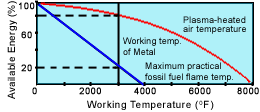Plasma is a high temperature ionized, conductive gas, which is created within the plasma torch by the interaction of a gas with an electric arc.
This interaction dissociates the gas into electrons and ions, which enables the gas to become both thermally and electrically conductive.
The conductive property of the ionized gas in the arc region provides a means to transfer energy from the arc to the incoming process gas and. in turn, to the process or furnace. This state is called "plasma" and will exist in the immediate confines of the arc within the torch.
By the time the gas exits the torch, it will have largely recombined into its neutral (non-ionized) state. However, the gas will still maintain its superheated properties.
Of the many methods used today to impart heat into a process, most are typically limited to the combustion temperature of the associated fuel. By having the unique capability of increasing the energy of the process gas two to ten times higher than conventional combustion equipment, the plasma technology offers several distinct advantages over traditional methods.
 Fossil Flame Air Temp. vs Plasma Heated Air Temp.
Fossil Flame Air Temp. vs Plasma Heated Air Temp.
Because the process energy for the plasma torch system is provided by direct heat transfer from an electric arc, gases of widely varying chemical composition may be used. These include control of process variables, such as exact temperature regulation, process gas flexibility and increased process-operating temperatures not possible by conventional means.
